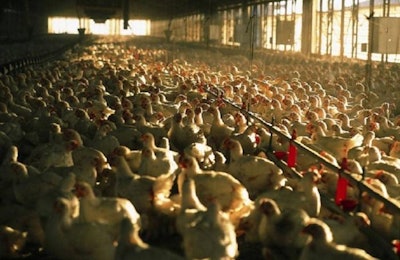
Sanderson Farms saw its net income drop dramatically during the first quarter of fiscal year 2016, going from $66.5 million to $10.7 million on a year-over-year basis.
Net sales were also down when compared to the first quarter of fiscal year 2015, as the most current quarter, ending January 31, 2016, saw net sales of $605.2 million, down from the $667.4 million in net sales for the first quarter of fiscal year 2015.
The poultry company, which is currently constructing a poultry plant in St. Pauls, North Carolina, and is ramping up production at a new plant in Palestine, Texas, cited weak market prices, lower export demands and higher tax rates as challenges it faced during the quarter.
"Our results for the first quarter reflect significantly weaker market prices for products sold from our big bird deboning plants compared with last year's first quarter," said Joe F. Sanderson Jr., chairman and chief executive officer of Sanderson Farms.
"Poultry market prices for our tray pack products sold to retail grocery store customers were only slightly lower when compared with the same period a year ago, and we also experienced lower grain costs. As a result, margins on tray pack products remained strong. On the other hand, the food service market is over supplied, primarily as a result of continued weak export demand. Poultry products that would normally be directed for sale in the export markets are instead being sold in the domestic food service market. While conditions improved in January, headwinds remain in the export market even though most avian-influenza related bans on United States poultry products have been lifted. Currency issues, political issues and weak oil prices remain."
Higher tax rate
The company's results were also affected by a higher effective tax rate. Sanderson Farms’ effective tax rate for the three months ended January 31, 2016, was 44.9 percent as compared with 35.2 percent for the three months ended January 31, 2015. The increase in the effective tax rate is primarily attributable to the company's decision to take advantage of legislation enacted during December 2015 that allowed for bonus depreciation to be taken on qualifying assets placed in service during the 2015 calendar year. This legislation, and the company's election to accelerate depreciation on these items, resulted in a favorable impact on the company's first quarter income tax receivable, but had an unfavorable effect on tax deductions that are based on or limited by levels of taxable income. The higher effective tax rate cost approximately $2.0 million, or $0.09 per share, net of income tax, the company stated in a press release.
Had the company not elected to take advantage of the legislation, the effective tax rate would have been 35.1 percent, and the Company expects its effective tax rate to return to approximately 35.1 percent for the balance of fiscal 2016.
Market prices affect Sanderson Farms' performance
According to Sanderson, overall market prices for poultry products were lower during the first quarter compared with the same period last year. Compared with the first fiscal quarter of 2015, the average Georgia dock price for whole chickens was approximately 0.8 percent lower, boneless breast meat prices were approximately 21.6 percent lower, the average market price for bulk leg quarters decreased by approximately 48.4 percent, and jumbo wing prices were lower by 2.7 percent. The company's average feed cost per pound of poultry products processed decreased 2.9 cents per pound, or 10 percent, compared with the first quarter of fiscal 2015, and prices paid for corn and soybean meal, the company's primary feed ingredients, decreased 1.8 percent and 20.9 percent, respectively, compared with the first quarter of fiscal 2015.
"Near record corn and soybean crops harvested in the United States last fall contributed to healthy soybean and corn balance tables headed into the 2016 planting season," added Sanderson. "Lower grain prices provided a significant tail wind during fiscal 2015, and had we priced all of our fiscal 2016 grain needs at yesterday's prices, our grain costs would be lower by $61.4 million during fiscal 2016 compared with fiscal 2015.
















